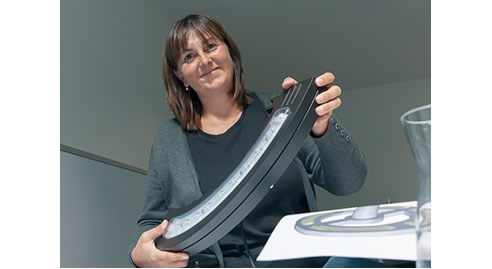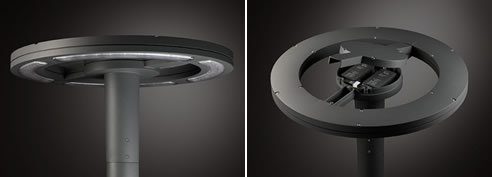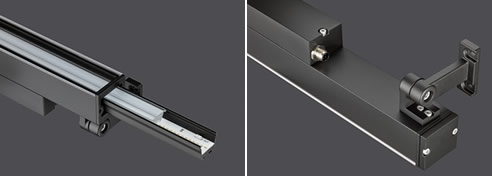Design and LED Technology from WE-EF

Petra Denst, Design Manager at WE-EF.
Revolution and evolution
Design in the era of LED: how WE-EF is turning challenge into opportunity
The light-emitting diode (LED) has given an enormous boost to innovation in the lighting industry. It requires new structural and creative design approaches, even in the case of outdoor luminaires. WE-EF has skilfully turned this challenge into an opportunity and has implemented a new product language. Timeless, high-quality, cost-effective - these are crucial elements in design and engineering, and the "Intelligence of Light" programme.
Challenges and opportunities are often closely linked, and LED technology is no exception. The LED has made the design of luminaires more complex, but also given it more options. "The life cycle of a street lighting luminaire is far longer than 10 years; ultimately it's an investment product. The design needs to remain relevant throughout this period, so fleeting trends cannot be allowed to drive design in this case," explains Petra Denst, Design Manager at WE-EF, in describing the framework for technology and design.
Street lighting luminaires require lasting design
WE-EF defines its own design language as "timeless, clean, purist and, of course, precise", remaining unobtrusive and avoiding preferences for any particular form. Exterior luminaires must be able to fit into different architectural or town planning contexts, both during the day and at night. Structurally streamlined, clearly proportioned WE-EF luminaires are particularly successful in achieving this criterion. The devil is in the detail here - for example, transitions in form and shape need to be designed with particular care.


WE-EF CFT540 Post Top Luminaire.
WE-EF creates a complete product concept from start to finish
WE-EF espouses core brand value combinations such as progressive/innovative, timeless/high-quality and classical/practical,
part of which are aspects such as ease of assembly, ease of maintenance and ease of repair. "The 'Intelligence of Light' claim also reflects the start-to-finish thinking behind our products. Good design is not only a question of form." Petra Denst points out. Therefore, she always considers the bigger picture in her designs, both internally and externally. Ultimately, the most coherent design is of little use if the final product cannot be feasibly manufactured or is extremely difficult to create.

WE-EF VLR100 Wall Luminaire - Surface mounted.
A design cannot exist without engineering
"We work together to refine the details, distances, wall thicknesses, shape transitions, volumes and installation space on the computer", Petra Denst explains. The importance of this process tends to be underestimated; "The LEDs themselves are getting smaller and smaller, but unfortunately the required electronic hardware components are not shrinking at the same rate." Prototypes, usually made from machined aluminium, are used to optimise the product, mainly in terms of thermal management. "We take temperature measurements under real-world conditions and modify the elements required for heat-sinking accordingly", Petra Denst emphasises.
Development marches on
"The 'Intelligence of Light' programme is a commitment that we make each day as we constantly explore the scope and possibilities for design innovations," explains Petra Denst. An excellent example of its approach is the ring-shaped CFT540 surface-mounted luminaire, for which the design would not have been possible at all without LED technology. "This technology is only in its infancy", adds Robert Diedrich, "and the short innovation cycles that have been common for LEDs continue to promise much for the future. However, we have to be willing and able to follow these trends."

|







 Modern Catenary Solution Fit for
Modern Catenary Solution Fit for WE-EF's New Managing Director for
WE-EF's New Managing Director for A New Era for WE-EF LIGHTING – A Home
A New Era for WE-EF LIGHTING – A Home Myers Park Lighting Upgrade:
Myers Park Lighting Upgrade: Bridging the Past and Future: Old Murray
Bridging the Past and Future: Old Murray WE-EF Profile Projectors for Sharper
WE-EF Profile Projectors for Sharper Award-winning Bay Pavilions, Arts +
Award-winning Bay Pavilions, Arts + Enhancing Transit Experience at Byron
Enhancing Transit Experience at Byron Intelligently Illuminating the Bay Run
Intelligently Illuminating the Bay Run WE-EF Lighting's Role in Protecting
WE-EF Lighting's Role in Protecting Sustainable LED Upgrade Kit from WE-EF
Sustainable LED Upgrade Kit from WE-EF A Natural Paradise Rottnest Island by
A Natural Paradise Rottnest Island by WE-EF LIGHTING's Braeside Expansion
WE-EF LIGHTING's Braeside Expansion Street and Area Pole-Mounted Luminaires
Street and Area Pole-Mounted Luminaires Smart Lighting Control Technology from
Smart Lighting Control Technology from High-Output Floodlights with Modern LED
High-Output Floodlights with Modern LED Bondi Beach Pavilion Reimagined by WE-EF
Bondi Beach Pavilion Reimagined by WE-EF Balancing Needs: Sea Turtle Conservation
Balancing Needs: Sea Turtle Conservation Architecturally Pleasing Recessed
Architecturally Pleasing Recessed Luminaires for Lake Macquarie Multi-Arts
Luminaires for Lake Macquarie Multi-Arts
